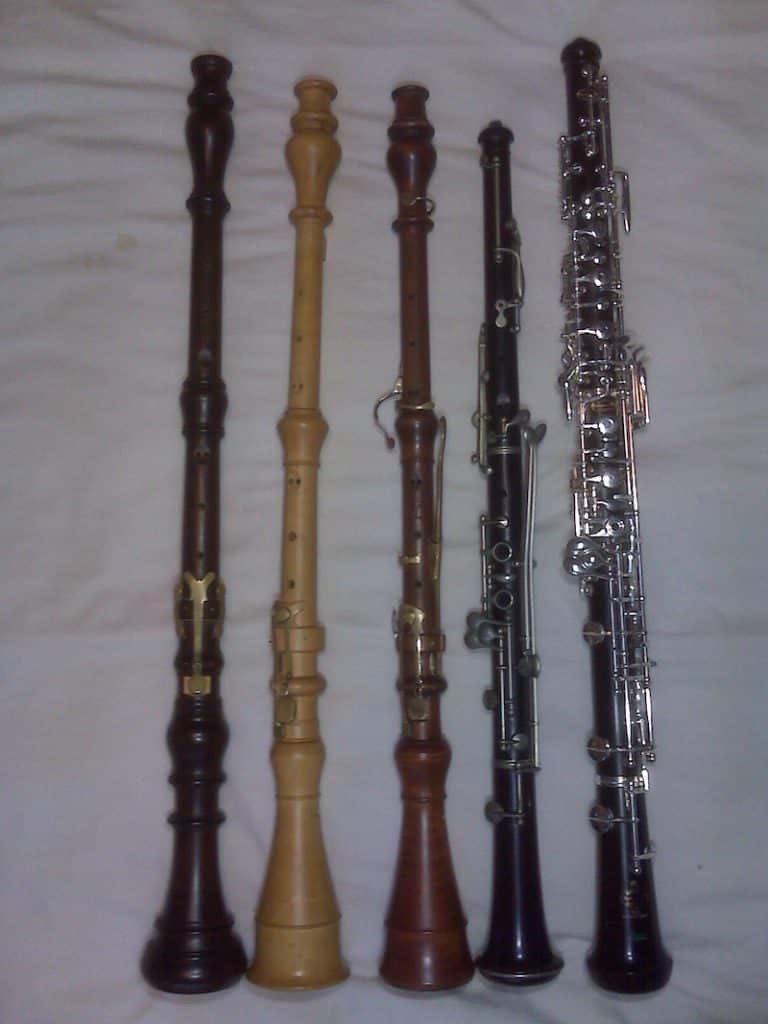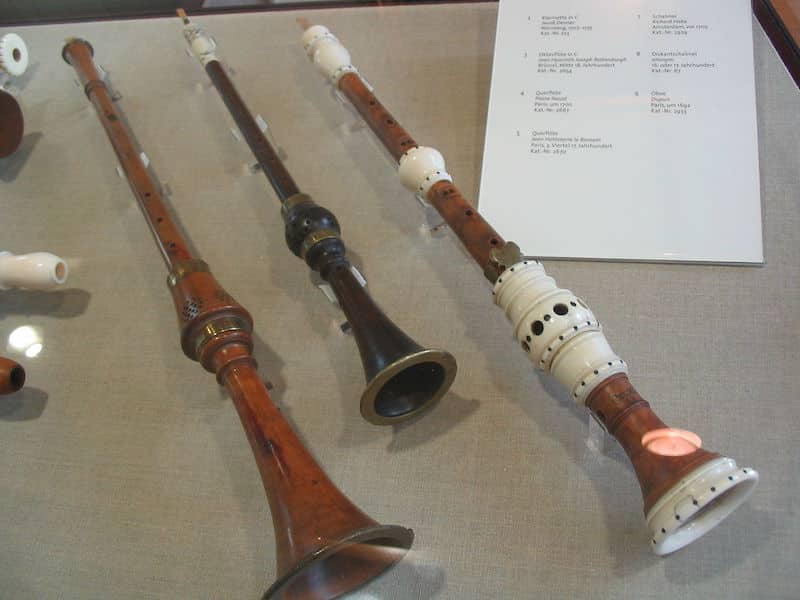The oboe is among the most unique, dynamic instruments you can play. The double-reed woodwind instrument produces some memorable music and a hauntingly beautiful sound for both solo and ensemble performances!
I bet you’re curious about the instrument. It’s not as popular as guitars and pianos, which drives more curious eyes!
Here are 20 interesting facts about the oboe that you might not have known:
1. The Oboe Has a Rich History
The earliest oboe-like instrument was the shawm, a medieval reed instrument from the 14th century which was played mainly for military purposes.
The oboe descends from the shawm with the first one likely tracing back to the French court of Louis XIV in 1657.
After that, the oboe became a part of classical orchestras at the beginning of the 18th century, but the final form that’s used today was created in 1906.
The original oboe was known as “hautbois” in French, a compound word translating to high wood. Really it became known to mean ‘high-pitched woodwind.’
2. The Oboe Belongs to the Woodwind Family
The oboe belongs to the woodwind family, which also includes the flute, piccolo, English horn, clarinet, and bassoon.
As the name implies, the woodwind family derives its name from the material that forms the instruments were made out of. Wood.
Today, these instruments are often made out of metal, plastic, wood, even brass or a combination of those materials.
3. An Oboe Plays a Major Role in an Ensemble
The sound of an oboe can pierce through the whole ensemble and is one of the most distinct sounds in an orchestra or band.
Composers often use the oboe’s sweet singing quality and expressive tone to carry beautiful melodies; it’s used in many lyrical passages of literature, and to add flair and sparkle to a composition.
Oboes are often found in orchestras, chamber music, concert bands, folk music, jazz, pop, rock, and film music.
4. The Range of an Oboe Spans 2.5 Octaves
The modern oboe’s range reaches about 2.5 octaves and merges beautifully with all the other instruments.
It can be very agile, reaching a range of B3 flat–A6.
The bass oboe has a lower pitch than the modern oboe and has a range of B2–G5 flat.
The modern oboe can have a higher range sometimes, but the highest notes may have a poorer tone than the lower ones.
5. There Usually are 2 or 3 Oboes in an Orchestra
An orchestral oboe section usually includes two or three oboes and an English horn.
The main part is the soprano line, with the second often supporting in the lower range of the instrument.
The English horn acts as the tenor voice, offering depth to the sound of the two oboes.
The various pitches produced by oboes in an orchestra take us on an emotional roller-coaster with haunting, warm, velvety, smooth, sad, and wistful notes.
6. The Oboe Plays the Tuning Note in an Orchestra
In an orchestra performance, the first thing you’ll hear is the oboe’s A note (the standard tuning note), followed by the other instruments playing an A and the entire orchestra tuning with each other.
This is the moment announcing the start of the concert.
The penetrating sound of the oboe stands out and is easy for all the musicians to hear, and its stable pitch is a reliable tuning source.
7. The Oboe is Different From the Clarinet
The oboe looks so similar to the clarinet; they’re often confused with each other. However, they’re only similar in appearance.
The oboe has a double reed, unlike the clarinet’s single reed.
Also, the bore size of the clarinet is a lot bigger, and the fingerings for the notes are very much different.
8. The Oboe is a Very Difficult Instrument to Play
The oboe can be one of the most challenging woodwind instruments to learn to play because of its often counter-intuitive technique, articulation challenges, issues with reeds, and the lack of experienced teachers.
As a beginner, the embouchure (use of facial muscles and shaping of lips to the mouthpiece), will take time to practice.
You must also have a profound musical ear since you’ll always be tuning.
Playing the oboe will require diligent practice, but after the initial difficulty, it’ll be rewarding.
Once you play a good tune, you’ll be hooked on the instrument forever.
9. Professional Oboe Players Make Their Own Reeds
Learning to create your reeds for the oboe is a must after a certain level.
To make the double reed, a piece of bamboo cane is folded in half and fastened.
You then cut the folded end to create two separate blades.
Afterward, you scrape them thin and try their sound.
They should be vibrating against each other, producing the sound you want when you blow.
Making your reeds could also be very rewarding if you enjoy handiwork.
Professional oboe players usually make their quality reeds to ensure they suit their needs, and many even sell them.
10. A Good Oboe Reed is Essential

The reed is the reason why the oboe sounds so beautiful.
Buying or making good reeds and replacing them often is a must for an oboist.
To make your oboe-playing experience much more enjoyable, you need a reed that’s easy to blow through and get a solid tone out of.
Its opening should be comfortable, and it shouldn’t call for too much manipulation with your mouth to play in tune.
11. The Oboe has Several Relatives

The Cor Anglais (English Horn) is a larger relative of the oboe.
They’re both wooden, conical, double-reed instruments producing sweet melodies.
The Cor Anglais has a lower pitch than the oboe and has a more resonant, melancholy tone.
The oboe family also has other members, including the original Shawm, the Oboe D’Amore, the Musette (piccolo oboe), and the Heckelphone (bass oboe).
12. An Oboe Needs Careful Maintenance
Unlike the clarinet or other instruments in the string or brass families, the oboe needs constant maintenance to lengthen its lifespan.
It’s so delicate and precise, so you need a specialist to adjust and maintain your oboe correctly.
Doing so could also save you some expensive bills if the oboe is badly affected.
You can sell your oboe for much more money if you keep it well-maintained.
13. Playing the Oboe Is Relatively Expensive
The oboe can be one of the most expensive instruments in an orchestra.
It’ll need replacement every 10–15 years—sooner than that if you play it professionally.
Also, the cost of reed supplies, tools, and gadgets can add up.
Oboes are expensive due to the cost of the materials and the skill involved in making them.
An oboist may have to spend an average of $7500 over a few years, but many hobbyists can make it work on a much smaller budget.
14. An Oboist Can Have a High Earning Rate
Experts that play, teach, and maintain the oboe are fewer and much harder to find than other instruments, making them widely sought-after.
They’re some of the highest-paid musicians, but skill and experience play a significant role in their earning rates which on average is around $60k a year.
15. The Oboe is Frequently Featured in Film Music
The oboe is often used in films to highlight an emotional or sad scene.
Oboes are renowned instruments in film music, having been featured in a lot of memorable movies such as Born on the Fourth of July, Gabriel’s Oboe Theme in The Mission, Across the Stars theme in Star Wars: Episode II and the Love Theme in The Godfather.
16. Oboe Is Featured in Many Classical Works and Pop Songs
The oboe is the main instrument in many renowned classical works, including Ralph Vaughan-Williams’s Oboe Concerto in A Minor and Richard Strauss’ Concerto for Oboe.
As well as classical music you’ll hear it pop up in some pop songs too.
Kiss From a Rose by Seal, Last Dance by Donna Summer, Dandelion by The Rolling Stones, and Bright Eyes by Art Garfunkel are also famous pop songs that feature the oboe.
Summing Up Oboe Facts
As you can see, the oboe has come from a long way back to enrich our lives with its sweet tones and translate our thoughts and feelings into music so touching and meaningful.
It’s been the choice of many renowned musicians through the decades.
We hope the above facts have inspired you to enjoy some beautiful oboe solos and ensembles, and maybe make some soul-soothing music.


